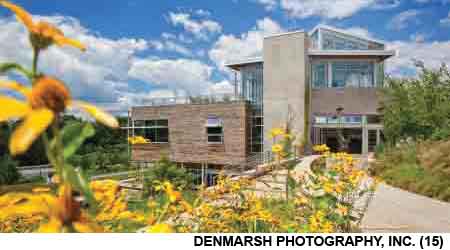Strategies in Existing Facilities Include Using Stairs to Get People Moving
Part 3 of a 4-part article on using building design and operations to support wellness
Even given the limitations of existing facilities and tight budgets, there’s still a lot that facility managers can do to foster wellness through their facilities. As in new construction, one hallmark strategy is to focus on the stairs. Granted, facility managers can hardly construct grand central staircases, but they can make the stairs they do have accessible, visible, and attractive.
The Active Design Guidelines were created in 2010 by the City of New York to promote physical activity in its portfolio, which is predominantly existing buildings. “One of the big wins that was achieved was opening up the stairwells in the vast majority of New York City’s public buildings,” says Joanna Frank, executive director of the Center for Active Design, which was created to promote the guidelines.
Use of stairs, even six flights a day, has been shown to have a real tangible effect on people’s risk of stroke and improvement of their health, Frank says. “So opening stairwells in existing buildings was found to be something that was very possible, even within New York City’s portfolio.”
At the most basic, stairs need to be opened up from a security standpoint so people can travel between desired floors without setting off alarms or getting locked out. Ideally stairwells would have glass doors, Franks says, so that people could easily identify the location of the stairs, be reminded to use them, and would feel safer about going into the stairwell. But even opaque doors can be painted with a bright color to bring attention to the stair’s location.
At the courthouse in San Benito County — which was designed to have showpiece public stairs — the back-of-the-house stairwells, accessible only by staff with a key fob, were still treated with added consideration to encourage their use. One wall was painted with an accent color and better than average lighting fixtures were specified. “It’s just a paint color, but it says, ‘We care.’ We want people to enjoy even the back staircase,” says Miyake.
Making it easy for people to navigate to the stairs is equally important. In existing facilities, the central bank of elevators usually has pride of place in the lobby, so signage that points out the location of the stairs as soon as people enter a building is important to encouraging stair use. In addition to navigational signage, motivational signage also plays a role. Signs that show how many calories are consumed by going up the stairs, or how many steps it will take, can provide a little boost of motivation to use the stairs.
Another strategy to consider is making small choices that will encourage facility occupants to move a little more in their days. Alan Hedge, a professor in the department of design and environmental analysis at Cornell University, says some companies have removed vending machines from every other floor, making people walk just a little further if they want that midday snack. Removing printers from desktops and providing a central network printer is another way to encourage facility occupants to move around.
On the topic of encouraging movement, sit/stand desks are gaining traction in the marketplace. However, as with any new behavior, effective education and change management are required to make this a successful strategy. Hedge says the track record thus far isn’t so great for the solution, as after as little as a month people often are not using the adjustability and just leave the desk in a sitting position. “Much like when you make a New Year’s resolution to get fit and you buy all the equipment and a month later it’s all sitting in the basement,” Hedge says. “Usually to make things effective you have to combine not only the products and the places, but put some kind of programming in place that encourages people to use those capabilities.”
Frank says the Center for Active Design has just launched a study with funding from ASID looking at the long-term impact of people who use sit/stand desks.
Focusing on how mechanical systems are impacting lighting, air, and water quality is another frontline strategy for facility managers in existing buildings, says Arias. Facility managers can include considerations such as how well the light from a light fixture can support circadian rhythms when it comes time for a lighting system upgrade. Maintaining proper operation of air filters, keeping coils clean, and using operable windows only when the outside air is cleaner than the inside air are all elements to keep in mind. And providing access to fresh water is important, achieved through monitoring water purity, consistency, and pressure, Arias says. “The overall plumbing health of the building is highly vital,” says Arias. “Energy is still a participant in the consideration, but when you have adequate and high quality water provided, it keeps the occupants optimal.”
Related Topics:















